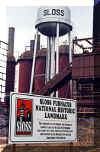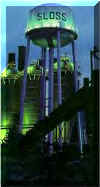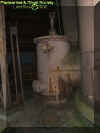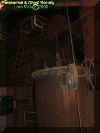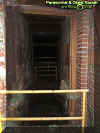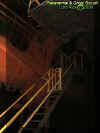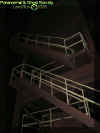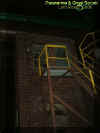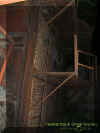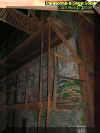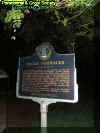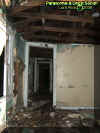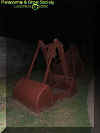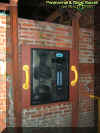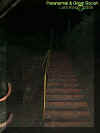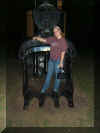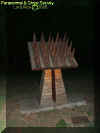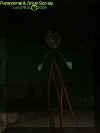|
|
||
|
Just after 1864 the Civil War many land developers, speculators and railroad men moved to the Jones Valley to take advantage of all its mineral resources. All the ingredients need to make iron were within a 30 mile radius as Iron Ore was found threw Red Mountain and most of Jones Valley. In the same area coal, limestone, dolomite and clay also were present. In 1871 the city of of Birmingham was found and the town was used to exploit its minerals. One of these entrepreneurs was Colonel James Withers Sloss who was an Alabama merchant and railroad man. He was perhaps one of the founders of Birmingham as he convinced the L&N Railroad to capitalize completion of the South and North rail line in Jones Valley the site of the new town. Sloss in 1880 helped form the Pratt Coke and Coal company which mined and sold the cities first high grade coking coal and eventually that led to him finding The Sloss Furnace Company. Two years later the second blast furnace was installed in Birmingham. Construction of the Sloss's new furnace called city Furnaces began in 1881 when the grounds of a fifty acre site were donated by the Elyton Land Company. Harry Hargreaves was born in Europe was the engineer in charge of the construction. He was an apprentice of Thomas Whitwell who was a British Inventor who designed stoves that would supply the hot air blast for the new furnaces. The furnaces were sixty feet high and eighteen feet in diameter. The furnaces were the first of there type in Central Alabama and similar to the ones up north in industrial cities like Buffalo where I am from. The factory would become a southern manufacture of iron as it had two blowing engines and ten boilers thirty feet long and fort six inches in diameter. In 1882 the furnaces opened and during its first year 24,000 tons of iron were sold. During the Louisville Exposition of 1883 Sloss Furnaces had won a bronze medal for the "Best Pig Iron" The pig Iron production would grow from 70,000 tons to 706,000 tons with no fewer then 19 blast furnaces. In 1881 Sloss was even a candidate of governor. They said his splendid character, business qualifications, intellect, Christian Integrity etc made him one of the grandest men in Alabama almost receiving a degree as high as military heroes. In 1886 Sloss retired and sold the company to a group of financiers The company was renamed in 1899 as Sloss-Sheffield and became the second largest merchant pig iron company in Birmingham. The company had expanded over the years to seven blast furnaces, 1500 beehive coke ovens, 120,000 acres of coal and ore land, five Jefferson County coal mines, two red ore mines, brown ore mines, and quarries just outside of Birmingham. By WWI Sloss Sheffield was among the largest producers of pig iron in the world. In the late 1930s WWII it expanded the market for iron and steal which created alot of jobs for the locals of Birmingham and in 1941 half of the labor force was employed by this type of industry in the area and almost all of them were African American. The 1960s became a harsh time as it was segregated. The workers bathed separately in different bath houses, punched separate time clocks, attended separate company picnics and even the task were segregated. The company was a hierarchy at the top were your white managers, chemist, accountants and engineers. The blacks merely assisted all the way up to 1928 then slavery was transformed during the work place. The blacks were restricted to helpers only as whites were boiler makers, carpenters, machinist, stove tenders etc. Birmingham Grew and low cost housing was being built some of them 48 houses right on the Sloss site mainly for the blacks and were called "The Quarters". The houses had two rooms set on a foundation post. It would attract family men which would allow a supply of labor at the factory. There was a doctors office and commissary on site. The workers paid for items bought at the commissary with company script. Later on their goods were bought with credit. The community had bbq's, watermelon cuttings, chittlin suppers, dancing and even baseball games. The company provided plots of land for flower and vegetable gardens, chickens, and even hogs. Nearby was the Thomas Elementary School where children could get an education in the 1930s and 1940s. So the quarters were a safe haven for the workers and the community had the same goals all working hard to produce iron while making a living to provide for there families. The quarters dismantled in the late 1950s only a few of them stand today but residents eventually started to disperse. In the 1960s and 1970s much had changed with the introduction of ductile iron and plastic pipe combined with the foundry trade's increasing reliance on scrap iron the pig iron industry was starting to fade. With stricter air pollution standers, competition from foreign imports and mismanagement in the industry resulted in a decline of American Iron and Steel. Sloss was starting to die as the U.S. Pipe and Foundry purchased the plant in 1952 and by 1969 it was the Jim Walter Corporation. By 1971 it was the oldest blast furnace in Birmingham and it was shut down. The Jim Walter Corporation donated the property to the Alabama State Fair Authority in hopes that it could be developed into some sort of museum. After several years of ownership they decided that the plant was not feasible and had plans to demolish it. The locals on the preservation board organized the Sloss Furnace Association to lobby for saving the site resting their arguments on its historic and cultural importance to the city. As well as its role as a symbol of technology that once made Birmingham one of the most industrial cities in the south. The project did get enough national attention and in 1976 the HARE, Department of the Interior, and City of Birmingham funded a survey of Sloss which documented its historical significance. The state Fair Authority then transferred control of Sloss over to the city and in 1977 voters passed the 3.4 million dollar bond to begin working on its preservation. By 1981 it was designated as a historical landmark and opened its gates in 1983 as a museum of the city. There is at least 40 something buildings at about 400-ton blast furnaces. The entire place is monolithic and amazing. Nothing remains of the original furnace complex from the 1800s however the oldest building on site is from 1902 and houses 8 steam driven blowing engines used to provide air for combustion in the furnaces. The engines date back to about 1900. The boilers installed in 1906 and 1914 produced steam for the site all the way to 1970 and they are in tact as well. But there are some new pieces of equipment to like the dehumidification plant which would reduce the consumption of coke. Today the factory is a museum concerts, civic events, innovative programs in metal arts etc are held here. Sometimes even festivals, workshops, and conferences as well. Although the area is very run down and old however with people visiting this historic site it has allowed it to have a chance at being rebuilt. Its a pretty eerie place surrounded by its railroad tracks, tunnels, dark paths around the furnaces, old equipment laying around etc. Sometimes in some areas you can feel the ghost of steal workers watching from its platforms or ladders. The water tower with Sloss written on it can be scene from across the city which leaves ones mind to wander what life was like years ago when steal was being produced and that is where we get into its Haunting's. Sloss Furnaces is said to be one of the most haunted places in Alabama if not the most famous. There is a story passed around that cruel foreman on the midnight shift at the furnaces worked their men relentlessly under grueling conditions with temperatures above 120 degrees. When this happened many men started to die from heat stroke and dehydration. Many paranormal investigators say that there are strange sounds, temperature, changes, feelings of being watched, streaks, and orbs. The city of Birmingham was called the Magic City cause it grew so quickly. I mean the factories would employ hundreds if not thousands of workers. Going back to the cruel foreman one does stand out in particular named James "Slag" Wormwood which he was in charge of 150 workers that would keep the furnace fed. It was a rough shift many of the poorest workers had this shift during the summer it was like hell. Some of the workers were immigrants and lived in cramped housing and were forced to fill in when needed. Wormwood wanted to impress higher management so he started taking more risk to speed up production. During that time 47 men died on the factory site 10 times more then any other shift in the history of Sloss Furnaces. That is not included the accidents, mishaps, or the explosion in the small blowing engine house in 1888 which left 6 workers blind and I believe 4 dead. The men were not given breaks or holidays they just worked constantly like slaves. In 1906 Wormwood lost his footing at the top of the highest blast furnace known as Big Alice plummeting to his death into a pool of melted iron ore. His body melted as he was still alive and in my theory I do think someone pushed him because of how harsh he was towards his crewmen. Some say he became dizzy from the methane gas created by the furnace and strangely he never set foot on top of any furnaces during his years here so quite strange nonetheless. After this incident the 3rd shift was canceled as to many accidents and strange occurrences started to happen that decreased the production of steal. Many of the workers were scared to work here after Slag disappeared into the ore. They said that they felt watched by an unnatural presence. A night watchman sustained injuries after being pushed by an unknown force which told him to get back to work. In the 1940s three supervisors turned up missing and were found locked up in a small boiler room. None of the three remembered what happened and they said a man approached them who was badly burned and was shouting at them to push some steel. Then we have another haunted tale about a Night Watchman named Samuel Blumenthal who was on duty the night before the plant closed. He was looking around when he came face to face with a half man half demon like creature who tried to push him. He said the beast had swung at him when he told the creature he would not go up the stairs to work. More then like it is Slag a very angry man perhaps about his death or perhaps his soul has manifested in the form of his anger. The night watchmen was found covered in burns and he did eventually die killed by this angry entity. So you see yes ghost can kill you do not let anybody fool you otherwise the paranormal can be a very dangerous thing if you do not know what you are doing. Over the years since then there have been many police reports on paranormal activity here from steam whistles blowing by themselves, to physical assaults to even sightings of factory workers. Most of the reports occur during the graveyard shift during September and October. Some of them sightings are of slag the angry foreman. Since that time psychics have visited the sights saying there is unnatural energy meaning something demonic roams the factory. There have been ghost videos here and evidence to prove its haunted. Some people go in here get cut up by unknown forces even one previous worker in the recent past caught on fire after seeing a strange shape in the flames the same time almost the night watchman was killed 32 years before. So in simple terms I really do think that we should get some Kudos considering it was just my exgirlfriend Ariel and myself that walked around this factory at night and its grounds. There are areas here that are beyond creepy I would almost say the furnaces come close to almost the asylums I visited up north. There is alot of activity, mixed feelings, strange noises and scents. The under pass even goes over the grounds and you can feel something watching from the tunnels, ladders, stairs, and even in some of the old quarters. The factory is located in an area that's very deplorable and I do find it to be a very unsafe area so let that be a warning for future adventurers cause its a real popular paranormal hotspot it was also the first place we investigated in the state of Alabama. I mean many men who died had died violent deaths falling into the ore or catching on fire near one of the furnaces. Some died from being worked to hard while some workers killed each other in disputes. It was a very successful place but it cost's many men there lives. In some ways I feel that it changed my exgf as well cause after we left here she started to act kind of different. Not everybody is ready for what we are trying to reveal to the public unfortunately. Lastly one part of history I want to discuss with my members is about the Duncan House which is also on the property. It was built in 1906 as a homestead for James and Lella Duncan along with there 8 children. Duncan worked throughout his life in nearby shops and yard of the L&N Railroad now CSX as a water boy, conductor and yard dispatcher. Donated to the Birmingham Historical Society in 1985 and was moved from its current location at Sloss Quarter the former sight of Sloss company housing for use as offices and to interpret the cities history. The structure is a representative of housing occupied by the middle of management during the period when Birmingham emerged as a major industrial center. One thing I can tell you is that the place is not just historical its very haunted when you have something grab you and then steal one of your rechargeable batteries before your eyes its time to say something is happening here. © By Rick-LordOfThyNight Reference: Sloss Furnances Homepage In accordance with Title 17 U.S.C. Section 107, any copyrighted work in this message is being distributed under fair use without profit or payment to those who have expressed a prior interest in receiving the included information for non-profit research and educational or criticism purposes only. Notwithstanding the provisions of sections 106 and 106A, the fair use of a copyrighted work, including such use by reproduction in copies or phone records or by any other means specified by that section, for purposes such as criticism, comment, news reporting, teaching (including multiple copies for classroom use), scholarship, or research, is not an infringement. Anotherwards a few photos are borrowed we do not make any profit off pictures mainly they are used for historical, criticism, theories and other educational purposes therefore we can use them as long as we do not claim them as our own or get paid for those photos specifically.
|
||
|
|
|







